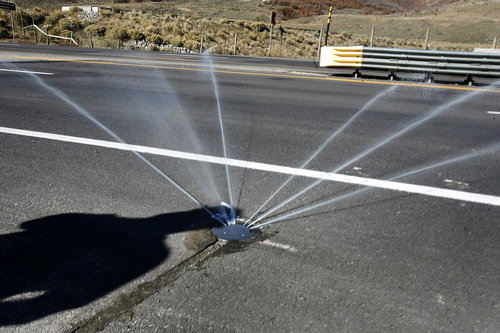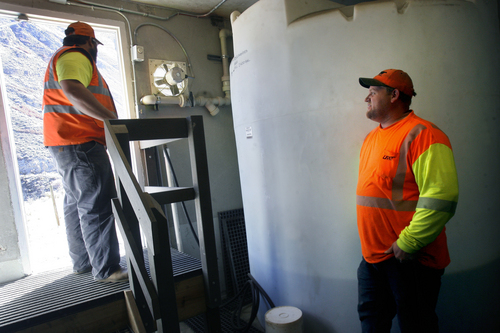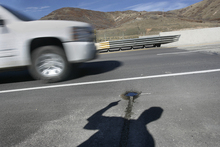This is an archived article that was published on sltrib.com in 2013, and information in the article may be outdated. It is provided only for personal research purposes and may not be reprinted.
As wintry weather approaches, how nice would it be to have a road that salts itself?
Actually, the Utah Department of Transportation has several bridges and intersections that do just that.
"This technology is called FAST, for Fixed Automated Spray Technology," says Greg Searle, urban district engineer for UDOT's Region 3 in central Utah.
"It treats our road surfaces with anti-icing liquids" from sprinklers, he says. Sensors monitor the temperature plus atmospheric and pavement conditions. "When it's about to freeze, it automatically will spray the solution out onto the road, which keeps the ice from bonding to the pavement."
UDOT has been using the technology in a few key places the past few years: east-side Interstate 215 near the 6200 South exit, Interstate 84 in Weber Canyon and two sites in Provo Canyon — at the canyon intersection with State Route 92 as it heads toward the Sundance ski resort and on the bridge near Deer Creek Dam.
UDOT crews fill up 2,000-gallon tanks with briny solution once a year at each location. The system then automatically de-ices the road when sensors say conditions warrant.
"Where these are in more remote areas, it works fairly well for us," Searle says. "It sprays automatically, so it reduces the need for us to run a truck out there constantly."
It can be expensive. Searle says the system at the Sundance junction in Provo Canyon, for example, cost $390,000 a few years ago. So it is used only in places where danger is greatest from freezing, especially in remote areas.
The systems usually are placed on bridges, which freeze faster than surrounding roads because, Searle notes, "you have cold air under the pavement as well as on top."
But it also was needed at the Sundance junction, he adds, because "we had a history of accidents and tankers rolling over at that location." In the couple of years it has been operating there, "we've seen quite a reduction in overall accidents."
"It's an innovation that improves how we manage our resources," says UDOT spokeswoman Muriel Xochimitl. "We can focus our snow plowing in areas that need it most, while this helps to support our efforts. It improves safety as well."
She says atmospheric monitoring from the systems also is sent automatically to the UDOT traffic operations center and maintenance sheds. That help officials decide when to send out plows and salt trucks.
Over time, the data also help them identify patterns to better predict conditions that will require plowing and salting.
The system often detects the need for de-icing long before faraway officials become aware of problems. "In this area," Searle adds, "it can be clear down here in the valley and really be snowing up in the canyon. It's an innovative technology we are using to be more efficient."
And it's nifty to have some roads that take care of themselves.







